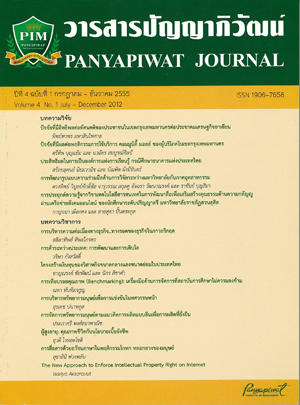การเทียบรอยคุณภาพ เครื่องมือด้านการจัดการที่สถาบันการศึกษาไม่ควรมองข้าม
Main Article Content
บทคัดย่อ
จากภาวะการแข่งขันของธุรกิจที่ทวีความรุนแรง เครื่องมือด้านการจัดการเริ่มมีบทบาทต่อการบริหารจัดการองค์กรในหลากหลายวงการ ทั้งอุตสาหกรรมการผลิต อุตสาหกรรมบริการ รวมถึงด้านการศึกษา การเทียบรอยคุณภาพเป็นเครื่องมือสำคัญที่ช่วยปรับปรุง พัฒนากระบวนการบริหารจัดการได้อย่างมีประสิทธิภาพ เป็นการพัฒนาองค์กรแบบก้าวกระโดด บทความเรื่องการเทียบรอยคุณภาพ: เครื่องมือด้านการจัดการที่สถาบันการศึกษาไม่ควรมองข้าม มีวัตถุประสงค์เพื่อทบทวนแนวคิดและทฤษฎีเกี่ยวกับความสำคัญ ความหมายของการเทียบรอยคุณภาพรูปแบบการเทียบรอยคุณภาพ กระบวนการดำเนินการเทียบรอยคุณภาพ การเทียบรอยคุณภาพสำหรับสถาบันการศึกษา รวมทั้งปัจจัยแห่งความสำเร็จและข้อจำกัดของการดำเนินการเทียบรอยคุณภาพของสถาบันการศึกษา ผู้บริหารสถาบันการศึกษาสามารถนำแนวคิดต่างๆ ไปปรับใช้ให้เหมาะสมกับบริบทของตนเองเพื่อการพัฒนาการบริหารจัดการ การดำเนินงานด้านต่างๆ ของสถาบัน รวมถึงด้านการจัดการเรียนการสอน ทั้งนี้เพื่อพัฒนาศักยภาพองค์กรให้เป็นองค์กรแห่งคุณภาพมุ่งไปสู่ความเป็นเลิศในวงการอย่างเป็นรูปธรรมและต่อเนื่องสามารถแข่งขันได้ในเวทีระดับชาติและนานาชาติต่อไป
Due to intense competition, critical management tools have played an important role in the management of a diverse organization, including manufactures, services and education. Benchmarking is an important tool to help these sectors improve and develop management processes effectively, leading to the development of a leap organization. This paper is entitled "Benchmarking: management tool that institutions should not overlook." and aimed to review concepts and theories of meanings and significance of benchmarking, benchmarking process and models, institutions benchmarking, including critical success factors and limitations. Administrators could apply such concepts and ideas as guidelines and adapt to suit the context of their own organization to improve the management, operations and teaching/ learning management. to improve their potentials to the level of concrete and continuous excellence and to be able to complete at both the national and international levels.
Article Details
“ข้าพเจ้าและผู้เขียนร่วม (ถ้ามี) ขอรับรองว่า บทความที่เสนอมานี้ยังไม่เคยได้รับการตีพิมพ์และไม่ได้อยู่ระหว่างกระบวนการพิจารณาลงตีพิมพ์ในวารสารหรือแหล่งเผยแพร่อื่นใด ข้าพเจ้าและผู้เขียนร่วมยอมรับหลักเกณฑ์การพิจารณาต้นฉบับ ทั้งยินยอมให้กองบรรณาธิการมีสิทธิ์พิจารณาและตรวจแก้ต้นฉบับได้ตามที่เห็นสมควร พร้อมนี้ขอมอบลิขสิทธิ์บทความที่ได้รับการตีพิมพ์ให้แก่สถาบันการจัดการปัญญาภิวัฒน์หากมีการฟ้องร้องเรื่องการละเมิดลิขสิทธิ์เกี่ยวกับภาพ กราฟ ข้อความส่วนใดส่วนหนึ่งและ/หรือข้อคิดเห็นที่ปรากฏในบทความข้าพเจ้าและผู้เขียนร่วมยินยอมรับผิดชอบแต่เพียงฝ่ายเดียว”
References
ช่วงโชติ พันธุเวช. (2547). การจัดการคุณภาพ. กรุงเทพฯ:มหาวิทยาลัยราชภัฏสวนสุนันทา.
ณตา ทับทิมจรูญ. (2552). การพัฒนาส่วนประสมการตลาดด้วยวิธีการเทียบรอยคุณภาพของสถาบัน เทคโนโลยีนานาชาติสิรินธร มหาวิทยาลัยธรรมศาสตร์ ดุษฎีนิพนธ์ปรัชญาดุษฎีบัณฑิต มหาวิทยาลัยราชภัฏสวนสุนันทา.
ทบวงมหาวิทยาลัย. (2545). เกณฑ์คุณภาพการศึกษาเพื่อการดําเนินงานที่เป็นเลิศ พ.ศ. 2545. กรุงเทพฯ ทบวงฯทัศนีย์.
ไพฑูรย์พงษ์. (2548). การเทียบรอย. กรุงเทพฯ - มหาวิทยาลัยราชภัฏสวนสุนันทา.
บุญดี บุญญากิจ และกมลวรรณ ศิริพานิช. (2545).Benchmarking ทางลัดสู่ความเป็นเลิศทางธุรกิจ กรุงเทพฯ: สถาบันเพิ่มผลผลิตแห่งชาติ.
สุพัตรา คูหากาญจน์. (2542). การพัฒนาการจัดการเรียนการสอนระดับบัณฑิตศึกษา ภาควิชาโสตทัศนศึกษา จุฬาลงกรณ์มหาวิทยาลัยโดยวิธีเบนซ์มาร์กกิ่ง กับแผนกวิชาวิทยาศาสตร์การสอน สถาบันการศึกษา แห่งชาติมหาวิทยาลัยนานยาง. วิทยานิพนธ์ปรัชญาดุษฎีบัณฑิต, จุฬาลงกรณ์มหาวิทยาลัย.
Ahmed, N. (2003). Higher Education, High Income Make Asian-American Market Attractive. National Underwriter, 107(16), 8-11.
Alshawi, S., Irani, Z. & Baldwin, L. (2003). Benchmarking: Information and communication technologies. Benchmarking: An International Journal, 10(4), 312-324.
Amin, M.R. & Amin, N.A. (2003). Benchmarking learning outcomes of undergraduate business education. Benchmarking: An International Journal, 10(6), 538-558.
Ammons, D.N. (2000). Benchmarking and a performance management tool: Experiences among municipalities in North Corolina. Journal of Public Budgeting, Accounting & Journal of Public Budgeting, Accounting & Financial Management, 12(1), 106-124.
Bain Management. (2011). Management tools and trends 2011. Retrieved February 9, 2012, from http://www.bain.com/management_ tools/Management_tools_and_trends_2011.pdf
Bateman, T.S. & Snell, S.A. (2004). Management:The New Competitive Landscape. New York:McGraw-Hill.
Bendel, T., Boulter, L. & Gatford, K. (1997). The Benchmarking Workout. London: Pearson Education, อ้างถึงใน ทัศนีย์ ไพฑูรย์พงษ์. (2548). การเทียบรอย. กรุงเทพฯ: มหาวิทยาลัยราชภัฏสวนสุนันทา.
Besterfield, D.H. (2004). Quality control. 9th ed.Upper Saddle River, NJ: Prentice-hall.
Bowerman, M., et al. (2002). The evolution of benchmarking in UK local authorities. Benchmarking: An International Journal,9(5), 429-449.
Breyfogle, F.W., Cupello, J.M. & Meadows, B.(2001). Management Six Sigma: A Practical Guide to Understanding, Assessing and Implementing the Strategy that Yields Bottom-Line Success. New York: John Wiley.
Brownlie, D. (2000). Benchmarking your marketing process. Long Range Planning, 32(1), 88-95.
Camp, R. (1989). Benchmarking. Milwaukee, OR: ASCQ Quality Press.
Carpinetti, L.C.R. & de Melo, A. M. (2002). What to benchmarking? A systematic approach and cases. Benchmarking: An International Journal, 9(3), 244-255.
Certo, S.C. (2003). Modern Management. 9th ed. Upper Saddle River, NJ: Prentice Hall.
Chapple, L. (2005). Funding and marketing trends for nonprofit arts organization: Case study, the Berkshire Music School (Massachusetts). Unpublished doctoral dissertation, University of Cincinnati.
Chung, W.K. (2001). Benchmarking Singapore's high-TQM maturity organizations. Benchmarking: An International Journal, 8(1), 8-34.

